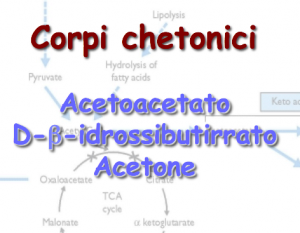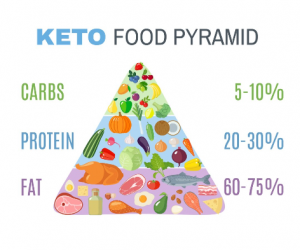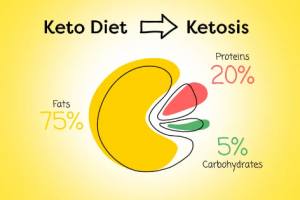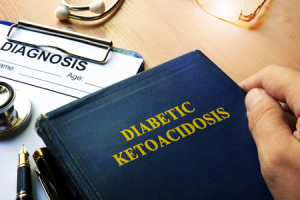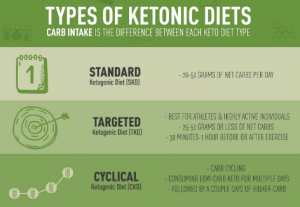Ketogenic Diet - Introduction
It is usually defined as a very low carbohydrate diet.
This is correct, but it can be more precise, because the breakdown of all 3 macronutrients must always be considered.
Here, more precisely, ketogenic is a diet that involves the introduction of very few carbohydrates, many fats and proteins.
Carbohydrates are allowed in very small dosages, even less than 50 grams per day. Just to give an example, an apple, depending on the size, contains from 20 to 35 grams of carbohydrates.
Just to have a term of comparison: a human being needs, on average, 180 grams of glucose per day.
Fig. 1 - A graphic representation of the breakdown of the 3 macronutrients, according to the dictates of the ketogenic diet
Ketosis, and ketone bodies (ketones):
The ketogenic diet owes its name to the fact that it induces our body to a metabolic condition, or metabolic state, if you prefer, called ketosis.
During the state of ketosis, our body produces i chetonic bodies, also called ketones.
There are 3 different types of ketone bodies, and they are:
1) Acetone
2) Acetoacetate
3) Beta Hydroxybutyrate
All 3 ketone bodies will tend to alter the pH of the blood, and more precisely they will tend to lower it. There is no need to worry, because our body is able to stop this trend.
But the state of ketosis does not represent a physiologically normal metabolic condition, and can be considered as a metabolic state of "emergency".
Under normal conditions, when eating a balanced diet, carbohydrates are converted into glucose by our cells.
In the diet of ketogenic diet, which involves a drastic cut in carbohydrates, the cells begin to affect the accumulated body fat.
After a period (usually 2 to 4 days) on a ketogenic diet, the liver cells break down fats and convert them into ketone bodies… we have entered ketosis.
Before getting to the heart of the topic, I would like to make 2 important clarifications:
- the ketogenic diet is effective when the goal is body fat loss;
- It is NOT dangerous.
Continuing reading, what has been said in these few lines will become much clearer.
Fig. 2 - The nomenclature of the 3 ketone bodies
From standard functioning to the functioning of the body in ketosis
In order to understand well the functioning of the body in ketosis, a brief explanation of the functioning in standard conditions, from the point of view of glucose, and fatty acids, is required.
By the way, glucose is an aldehyde monosaccharide ... in other words it is a sugar.
Fatty acids represent the fundamental components of lipids, where by lipids we mean the real fats. Basically our body burns glucose to produce ATP (adenosine triphosphate), which is the form of energy used by humans.
More specifically, we work thanks to a real fuel mixture, consisting of glucose is fat. If we walk slowly this biological fuel will be very rich in fat, and as we increase the pace it will be enriched with sugars.
Anyone interested in sports and nutrition will surely have heard that endurance athletes go mostly to fat, and that's right, since fat represents a large reserve of energy, and their athletic performance must last for a long time.
But the important thing, indeed very important, is not to run out never sugars, this is because, in order to provide the energy necessary for example for a marathon runner, they must be "burned", or rather oxidized. And this is possible thanks to sugars.
On the other hand this is a great truth contained in the saying: "Fat burns in the flame of sugars".
Under standard conditions, fatty acids undergo a reaction called Beta oxidation, from which Acetyl Coenzyme A originates, which will enter a very important cycle, called Krebs cycle, at the end of which it will be produced ATP, that is, the energy with which we function.
In fact, ATP is the energy we use in everyday life, and which allows, for example, the marathon runner to run for many hours, or the cyclist to pedal for many kilometers.
L'oxaloacetate represents the start molecule so that the Krebs cycle can begin, and oxaloacetate is obtained only from glucose.
But in the ketogenic diet there is a drastic cut in the supply of carbohydrates, in fact very few are introduced.
And from carbohydrates, glucose is obtained, that is the necessary element that allows the body to function normally, and that allows oxaloacetate to originate, thus effectively oxidizing fats, and obtaining the energy we need.
On a ketogenic diet, we have very little glucose available, and as if that weren't enough, our brains run on glucose.
Are we in trouble?
No because our body is able to surprise us, thanks to its incredible adaptability, and now I'll be clearer:
due to the lack of glucose, the cycle of Krebs is significantly slowed down, and at this point, much of the Acetyl Coenzyme A no longer enters the Krebs cycle, but takes another metabolic path, which leads to the creation of chetonic bodies.
When oxaloacetate is not present in the right proportions, compared to Acetyl Coenzyme A, the liver cells start producing ketone bodies.
Remember when I said our brains run on glucose? Well, our brain runs on glucose, but also on ketone bodies.
And the ketone bodies always guarantee us the energy we need, and they don't need any start molecule of oxaloacetate, the little bit of oxaloacetate that is used in a very slow Krebs cycle. Krebs cycle that will continue to produce energy in a reduced form, but we will enjoy the energy extracted from ketone bodies.
But conceptually how can we consider ketones?
We can consider them as emergency energy metabolites, as a real alternative fuel, which allows our body to function during the metabolic state of ketosis.
During ketosis there is an effective loss of fat mass, an effective loss of body fat.
Energy from fats, observations and considerations:
Fats are often referred to as a large reserve of energy, and that's the way it is, but what numbers are we talking about?
About 9 kilocalories can be obtained from 1 g of fat, which is a great result. Keep in mind that from 1 g of protein, or carbohydrates, you get about 4 kilocalories, which is not even half.
These 9 calories from 1g of fat are obtained via the traditional way of the Krebs cycle.
During ketosis, through the ketone bodies, 1 g of fat provides only 7 calories.
Is this bad or is it good?
Keep in mind that the ketogenic diet is done to lose body fat. So that's good, because we will have fewer calories to burn off, and at the same time the ketone bodies still provide energy, and make the brain work instead of glucose.
Ketogenic and ketone pros and cons:
Given that the ketogenic diet induces a real change in metabolism, leading us to the metabolic state of ketosis, let's see together the pros and cons:
It is certainly very effective in losing fat mass.
Sometimes it can be used as an antechamber for other diets, that is, it can be followed before moving on to other diets, always aimed at weight loss.
The true ketogenic diet has a recommended duration of 2 or 3 weeks, certainly a very short period, but a very important factor must be taken into consideration: we must always remember, that ketogenic was not born as a diet aimed at slimming, but as a diet able to effectively counteract childhood epilepsy.
In ketosis the body works in a kind of emergency mode, this can be fine for a period of 15 or 20 days.
It produces ketone bodies, which provide energy, and our brain uses them instead of glucose, but there is one but, indeed more than one:
the ketone bodies are expelled through sweating and pulmonary ventilation, giving an unpleasant acetone aroma to both our sweat and our breath. In addition, ketones are also excreted through the urine, it will increase diuresis, so we will also eliminate more water, increasing the risk of dehydration.
In ketosis you may suffer from a sense of exhaustion, and a dry mouth.
Fig. 3 - Over time a range has been given to the percentages of macronutrients, and real variants of the ketogenic diet have been born
Fig. 4 - The food pyramid of the true ketogenic diet, the most restrictive from the point of view of carbohydrate intake, and the most abundant as regards the percentage of fats to be introduced.
Ketonemia, let's give some numbers
The presence of ketone bodies in the blood is defined ketonemia.
But some distinctions should be made:
Our body produces ketones all the time, even if we are not on a ketogenic diet.
Under normal conditions, the values of ketone bodies in the blood are truly negligible, and are around 0.1 millimoles / deciliter.
On the other hand, we are talking about completely different numbers in the case of a state of ketosis, but be careful, because the ketogenic diet is not the only way to induce this metabolic condition.
Even particularly intense and prolonged physical activity is able to induce ketosis, and the ketonemia values in this case are 1 - 2 millimoles / deciliter.
With a strict ketogenic diet, ketonemia values of 5 - 8 millimoles / deciliter are obtained.
Ketonemia can be measured through blood tests, urine tests, or through practical strips of paper to be dipped in the urine.
Fig. 5 - Physical activity is also able to induce ketosis
Ketosis and ketoacidosis, be careful not to confuse them:
The ketogenic diet leads us to enter the metabolic condition of ketosis, with values of ketonemia of 5 - 8 millimoles / deciliter.
There ketoacidosis instead it has values of ketonemia even up to 25 millimoles / deciliter.
In ketosis there is a tendency, and I repeat a tendency, on the part of the acidity of ketones, to lower the pH of the blood.
In ketoacidosis there is a real and dangerous lowering of the blood pH.
Ketosis is a situation that our body is perfectly capable of keeping under control.
Ketoacidosis consists of a situation that our body cannot control, and can lead to coma and death of the individual.
You can go into ketosis on the ketogenic diet, but not ketoacidosis. Ketoacidosis is a complication of conditions, such as diabetes.
Fig. 6 - Ketosis should never be confused with ketoacidosis, the former can be induced with the ketogenic diet, the latter is a complication of diabetes
Ketogenic and ketogenic (variations on the theme):
When it comes to the ketogenic diet, it would be appropriate to specify which one means the true ketogenic diet, that standard, if it refers to the original version.
This is because, over time, about ten variants of the ketogenic have originated, if we also count the standard “progenitor” version.
Some ketogenic drugs can also be followed for several months, so much longer than the recommended 2 or 3 weeks of the standard ketogenic.
Among my personal friendships, I include several athletes who compete and stand out worldwide.
One of them, has been on ketogenic for a few months, plays a power sport, and his athletic performance is of all respects, he will be in Tokyo 2021.
My friend follows a modified ketogenic, in which the intake, through supplements, of high quantities of glutamine and arginine; these 2 amino acids have in common that they are neo-glucogenetic, ie capable of producing glucose. This is in stark contrast to the basic principle of standard ketogenic, but no wonder.
Keep in mind that there is a variant of the ketogenic, in which a cyclical refill of carbohydrates is expected.
Nutrition, consisting of nutrition and supplementation, is closely linked to physical activity, and one is a complement to the other.
Here are the 3 main types of ketogenic diet:
SKD: Standard Ketogenic Diet, the true ketogenic diet, the one that plans to introduce 75% from calories from fat, 20% from proteins, and only 5% from carbohydrates.
TKD: Target Keto Diet, is designed for sportsmen, and foresees, on the days in which sports activity is carried out, to introduce carbohydrates both before and after physical activity.
CKD: Cyclic Keto Diet, in this widely used variant, a cyclical refill of carbohydrates is foreseen, for one or two days a high quantity of carbohydrates is introduced.
Fig. 7 - The 3 main types of ketogenic diet


